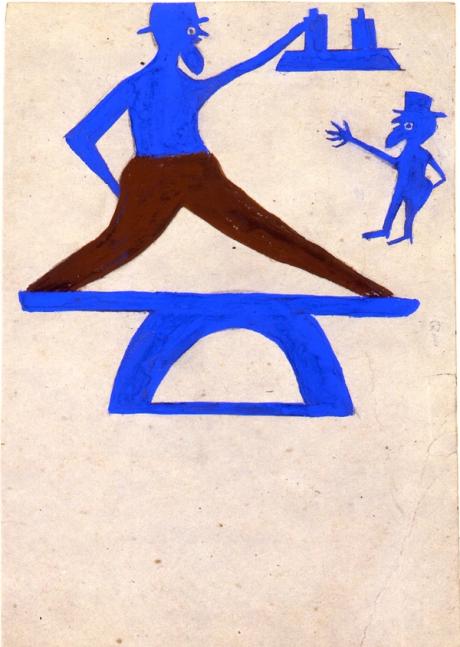
A major work by Bill Traylor (c. 1853-1949), a self-taught artist who was born into slavery and developed a striking and unique style of figurative painting late in life while living on the streets of Montgomery, Alabama , was donated to the American Folk Art Museum (AFAM) in New York.
The untitled composition on cardboard, which brings AFAM Traylor’s Artwork Fund four-piece, previously owned by Lanford Wilson, a playwright who won the Pulitzer Prize for Drama in 1980 for his romantic comedy Talley’s madness and died in 2011. It was donated to the museum by Tanya Berezin, an actress who, with Wilson, co-founded the famed Circle Repertory Company (which operated in Manhattan from 1969 to 1996).
“When Tanya Berezin gave it to the museum, I couldn’t believe it was real, it’s a masterpiece,” says Valérie Rousseau, chief curator of self-taught art and outsider art at AFAM. She adds that between the prevalence of fake Traylor artwork circulating on the market and the enormous value of her authentic work (her current auction record is $507,000), the possibility of such a piece being offered to the museum seemed far-fetched. “I thought it was a joke.”
The painting, executed in graphite and gouache on cardboard, is officially dated between 1939 and 1942. As is typical of Traylor’s work, it is untitled, although the descriptive subtitle added by a dealer, “Blue Construction, Figures, and Bottles; or Two Men Reaching for Bottles”, has been preserved. It presents several characteristics which are the quintessence of the artist’s practice, in the forefront of which the dominant cerulean blue which was a trademark of the artist’s iconography.
The painting depicts two figures reaching for bottles of moonshine on a high shelf. The tallest figure in the image, who stands atop a platform and wears brown pants, could be a self-portrait, according to Rousseau. “Because of the beard, because of the hat,” she said. “We have seen photographs of Bill Traylor on the streets of Montgomery and specifically sitting in front of the general store, which are very close to the features of this figure.”
The second, smaller figure, a sort of miniature or alter ego of the main figure whose pose it mirrors, recurs in many of Traylor’s works as a mischievous character. Rousseau adds: “This specific work illustrates the strength of his style that we all admire, the way he creates these tensions by placing figures and motifs in very specific configurations.
Traylor’s work has been featured several times at AFAM, including two simultaneous solo exhibitions in 2013. A reproduction of the newly acquired work was also featured in Bill Traylor, a 2018 book by Rousseau, Debra Purden and Margit Rowell. Nevertheless, Rousseau is keen to get to know the work better, especially by examining its back more closely. This, she hopes, will offer insight into how it was displayed, promoted and ultimately sold, via New York’s Hirschl & Adler Galleries, by the man who took much of the credit for brought Traylor’s work to a wider audience.
“Charles Shannon started collecting Bill Traylor’s works on the streets of Montgomery in 1939, which must have been the year Traylor started working,” she says. After showing and attempting to sell works from the 1,200-piece Traylor hoard he had purchased, with little success, Shannon sat on his collection for several decades before devising a new tactic.
“In the 1970s, he started to reconsider the approach he would take in the years to come, and he started dividing this whole collection of 1,200 works into micro-collections,” explains Rousseau. “And he was trying to have in each of these micro-collections representative examples that could be similar in each collection. So what I want to see on the back is which collection does this work belong to.
Eventually, one day, she would like to exhibit the newly acquired work with her “sisters and brothers” from Shannon’s micro-collection.
